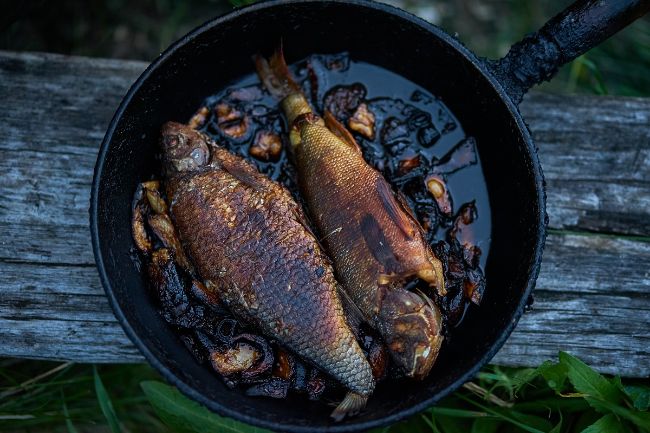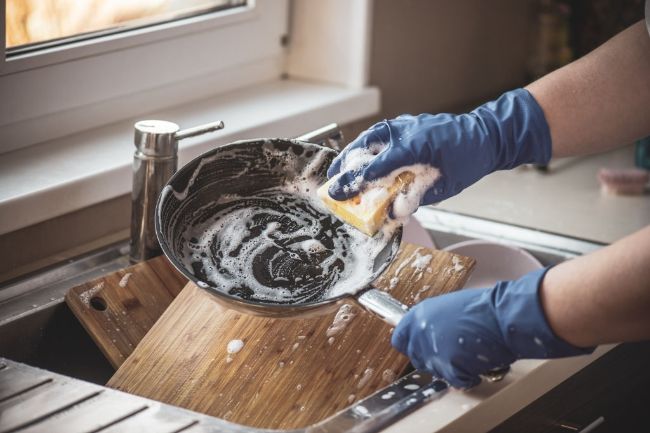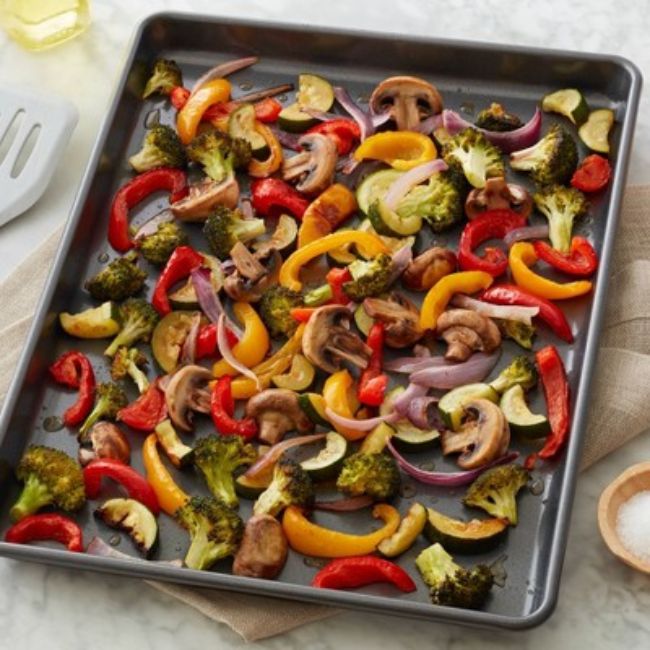Can calphalon pans go in the oven?
Yes! Calphalon pans are oven-friendly.
But it would be best if you guaranteed that the temperature is 450 degrees or less.
Whatever cookware you’re hunting for, it’s critical to determine whether they are oven-proof to prevent complications.
Calphalon is sold in tons of varieties.
Almost all types are versatile and might require precautions in their usage.
You should know that calphalon cookware is in the non-sticky category and enjoys great demand.
The reason behind their popularity is easy maintenance.
Now, let’s walk through the nitty-gritty of this renowned cookware!
How do I know if my Calphalon pan is oven safe?

To testify whether a calphalon pan is oven-proof, look for a particular oven-safe symbol at the bottom.
Along with this cookware, cast iron and stainless steel are other examples of oven-safe utensils.
Calphalon is highly professional cookware.
A signature non-stick pan is generally safe in the oven if you have set the temperature to 500°F or less.
If you wish to cover the calphalon pan with a tempered glass lid, the temperature shouldn’t exceed 450°F.
Related Readings: Reason Why Pans Wrap In Oven – Read More.
Why Does It Matter?
Why are people invested in non-stick pans, and why is everyone willing to learn information?
Non-stick pans typically are manufactured with petroleum-based Teflon material, and this is the cause of concern and curiosity.
This material demands more precautions.
The Teflon coating tends to deteriorate when high temperature is employed and can emit dangerous gases.
Which can lead to different health issues.
But not all brands utilize Teflon coating to manufacture this cookware.
They use various other coatings that are PFOA (Perfluorooctanoic acid) and PTFE (Polytetrafluoroethylene) free.
So, to be on the safe side, communicate with the calphalon brands to determine that the non-stick cookware is safe to be placed in the oven.
What is simply Calphalon made of?
The non-stick calphalon cookware is produced by merging two materials – Polytetrafluoroethylene and hard anodized aluminum base.
The former material gives rise to the non-stick coating.
This hard-anodized aluminum base shouldn’t make you worry as it won’t leach metal into the food.
Plus, it’s not reactive.
This safety results from the strengthened outer layer developed by the anodizing procedure.
The food never gets in contact with the hard-anodized aluminum due to the non-stick material.
Are Calphalon Lids Oven-Safe?
Yes. Calphalon lids are oven-proof at 450°F maximum.
You should know that the lids display tempered glass.
Moreover, the tempering procedure typically solidifies the lid.
Are Calphalon Pans Broiler-Safe?
No. Calphalon pans shouldn’t be placed in a broiler as the non-stick coating cannot bear the heat.
As unfortunate as it is, it’s important to remember.
Even if the cookware is placed in the broiler for some minutes, consider your investment lost.
Not only this, extremely poisonous gases will be emitted that are detrimental to birds and humans.
Know that putting any calphalon cookware in the broiler will permanently damage it and destroy your warranty.
This is the worst possible scenario.
However, there are some Calphalon pots and pans that are broiler-proof.
The handles are the only difference between the calphalon cookware that’s broiler-proof and not broiler-safe.
A few calphalon utensils come with silicone handles that can tolerate 400°F.
But even with this capability, it’s essential to practice preventive measures during broiling.
It’s not advised to broil for more than 10 minutes.
Can calphalon pans with rubber handles go in the oven?
It’s natural to wonder whether the handles are oven-proof or not after reading about calphalon lids.
Like the pan, the handle must tolerate a high temperature from the oven.
It’s common sense that plastic melts at high temperatures.
So, don’t place any cookware in the oven with rubber handles.
During heating, plastic emits harmful gases that can lead to the contamination of food.
Cooking in an oven with calphalon pans that are not oven-proof will not only harm the cookware but the stove too.
Furthermore, fire is highly probable as ovens function at high temperatures.
Even the handles, termed stay-cool, are only cool at the stovetop.
The only handles that stay the same at the oven temperature are phenolic.
Remember to see the temperature rating of a handle before placing it in the oven.
Last thing to remember: use a pot-holder or oven mitts to take the pan out from the oven, as the aluminum handle is hot and can cause burns.
Precautions When Cooking With Calphalon in the Oven
Because calphalon is oven-proof, it doesn’t mean there isn’t anything more to know regarding their usage.
The user needs to be very careful with this cookware.
So, let’s go over the crucial precautions for using calphalon cookware.
- As previously stated, an oven temperature of 450°F is safe for all categories of calphalon cookware. But this doesn’t mean you can place the cookware in the oven on the broiling setting.
- Any calphalon cookware manufactured by enamel cast iron or featuring a non-sticky label isn’t safe to be placed in a broiler.
- The broiler setting can harm the cookware and its non-stick coating.
- Only anodized calphalon cookware can tolerate oven heat. So, any other calphalon cookware shouldn’t be inflicted with 450°F.
Taking care of Calphalon Pots and Pans

If you’re impressed by this cookware so far, you must be wondering how to clean them!
We’ve covered this information below:
Related Reading: Effect Of Oven Cleaner On Kitchen Countertops – Click Here To Read More.
Let it cool down.
Don’t expose the calphalon to cold water after immediately taking it off the heat.
Allow it to cool down.
Otherwise, bubbles will form on the metallic coating, and the surface will be considerably harmed.
Use warm water.
Ensure that you’re employing warm water for cleaning.
It will easily eliminate stubborn stains clinging to the surface.
Don’t cut anything on the inside.
Calphalon is scratch-resistant, long-lasting, and can bear extreme temperatures.
But for optimum performance, don’t cut meat or fresh produce on the inside of the utensil.
Only hang the utensil.
Use calphalon cookware gently, and don’t store them by stacking them on top of other utensils.
Instead, hang the cookware on a pot rack or a store flat in one layer to prevent scratches.
Clean with soft material.
Utilizing a soft sponge or soft cleaning brushes is also suggested to clean calphalon pans.
Avoid brushes with harsh bristles that are metallic or wooden, as they can tarnish the shiny coat.
A washcloth made of soft material is another suitable option.
Polish.
It can be polished if you’re observing that your calphalon cookware is losing luster.
You can choose a specialized cleaner to restore the previous luster and make it appear new again.
The formula of the cleaner should be appropriate for non-stick and stainless steel utensils.
Hand washes only.
Calphalon cookware can be washed by dishwasher.
However, to maintain the shine and ensure that they don’t get harmed by the dangerous chemicals in the dishwasher.
It’s better to wash them by hand.
Opt for a liquid dishwashing soap and a non-abrasive cloth.
Utilize cleaners made for utensils.
Don’t employ:
- Harsh oven cleaners
- Cleaning pads
- Bleach
- Caustic cleaning solutions
- Baking soda
- Other types of common cleaners are designed for floor or porcelain.
These cleaners are not suitable for this cookware and will considerably harm the finishing.
Buff it!
Buffing can remove recent scratches and boost the appearance of this cookware.
Utilize a soft scrubbing pad to rub on the grain of the pan in circular motions.
After buffing out small scratches, use a specialized cleanser for non-stick utensils and wash thoroughly.
Don’t use a scratched utensil.
If your pan is significantly scratched, it’s time for a new one.
Please don’t use it again because, after the destruction of the non-stick coating, it’s useless.
The utensil will emit harmful chemicals that can affect your food and health.
Oven-Safe Temperature of Each Calphalon Collection
| Calphalon Collection | Oven-Safe Heat Rating |
| Calphalon Cast Iron | 500°F |
| William Sonoma Calphalon Elite Nonstick | 500°F |
| Calphalon Signature Nonstick | 500°F |
| Calphalon Tri-Ply | 500°F |
| Calphalon Contemporary | 450°F |
| Calphalon Classic | 450°F |
| Calphalon Premier | 450°F |
| Select by Calphalon | 400°F |
| Simply Calphalon | 400°F |
{Source}
Can Calphalon Pans Go In The Oven – FAQs
Can calphalon pans go in the dishwasher?
Calphalon cookware is safe to be used in the dishwasher.
But before the first use, wash the utensil with warm water and dry completely.
Preheat the utensil to the setting you will establish during cooking before adding oil or butter.
Are calphalon pans good
Calphalon cookware is durable, high-quality, and easy to maintain.
This means that any calphalon utensil is worth the investment.
Are calphalon pans safe
As long as the user remembers the precautions and ensures that the temperature limit isn’t crossed, calphalon cookware is super easy to use, clean, and maintain.
But if the oven temperature is set above 500°F and rubber/plastic handles are placed in the oven, you can expect some serious disasters.
Are old Calphalon pans safe?
As long as there are no scratches and you are not overheating the utensil, all non-stick calphalon utensils are safe.
Is Calphalon Everyday Pan oven safe?
The signature hard-anodized calphalon cookware features a 1.5 times more long-lasting non-stick interior for perfect food release.
It’s safe to be used in a dishwasher and oven up to 500°F.
They can also come with stay-cool handles.
Where is Calphalon’s signature stainless steel made?
The calphalon signature stainless steel is manufactured in China, whereas the non-stick is made in the United States.
Why is my Calphalon pan peeling?
The non-stick coating is made for long-term usage if utilized correctly and at the advised cooking temperature.
But if your calphalon utensil’s coating is peeling or chipping, and your cookware has been maintained as per the manual guide, you should start looking for a new one.
Related Readings: Roasting Pans vs. Dutch oven- Read More.
Final Thoughts
If you want to improve as a chef, don’t sleep on the calphalon cookware, which is famous in the culinary world.
Before using the utensil, consult the owner’s manual to know what treatments can harm the utensil.
They will offer a longtime service if you treat the utensils with care and respect.
Now that you’ve learned that calphalon cookware is oven-proof, don’t forget the precautions and practice the cleaning tips we have explained for the best experience.


